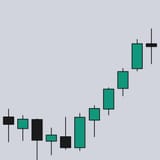🌊Mindset: Follow the Path of Least Resistance
The market may look chaotic, but there is order in the movement. Watch the waves. Study the current.

The Market Moves Like Water: Understanding Waves Through Wyckoff’s Eyes
In the world of finance, it's easy to get lost in numbers, charts, and screens. But beneath all the data lies a rhythm, a natural flow—one that mirrors the currents of a great river. Richard D. Wyckoff, a pioneer of market analysis, taught that price movement is not random. It follows the ebb and flow of human behavior, the timeless tug-of-war between supply and demand.
📈 Markets Move Like Water
Like a river, the financial market doesn’t move in straight lines. It twists, turns, pauses, and surges. Price doesn’t just "go up" or "go down"—it reacts to pressure, builds momentum, hits resistance, and sometimes overflows its banks in climactic bursts.
Wyckoff observed this through waves:
- Upwaves (rallies) are powered by demand overwhelming supply.
- Downwaves (declines) reveal the weight of supply pressing down on a tired market.
- Trading ranges—those calm pools where water collects before the next surge—represent accumulation or distribution, where large interests quietly prepare their next move.
⚖️ Supply and Demand: The Invisible Engine
Every tick on a chart represents a transaction—a moment when buyer and seller agreed on a price. But zoom out, and those ticks form patterns. Wyckoff's brilliance was in understanding who was behind those patterns.
- In accumulation, large operators quietly buy as the public loses interest.
- In distribution, those same players sell into strength, disguising their exits.
- Volume confirms intention—rising volume in a rally means strong demand; rising volume in a decline hints at aggressive selling.
🌪 Why Waves Matter
Imagine paddling on a river. If you ignore the current, you fight a losing battle. But if you understand the waves, you can flow with the market—not against it.
Wyckoff’s wave theory helps traders:
- Time entries during pullbacks (retracements)
- Exit near the top of a wave when signs of exhaustion appear
- Spot when the current is shifting before the crowd reacts
🧭 Trade with the Current
The market may look chaotic, but there is order in the movement. Watch the waves. Study the current. Feel the pressure building beneath the surface.
Whether you're an active trader or a long-term investor, Wyckoff's principles remind us that the market—like a river—has a language of its own. It speaks in waves, and those who listen can ride them with confidence.
